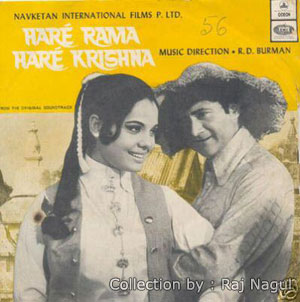Dum Maaro Dum

Film: Hare Rama Hare Krishna (1971)
Producer and Director: Dev Anand
Lyricist: Anand Bakshi
Singer: Asha Bhosle and chorus
Dum Maro Dum: My First Encounter
It was 1971. I was in High School.
One day while I was cycling my way to school located at a mofussil town in West Bengal, I heard a strange sound from the local music shop, which played records especially the newly released ones, to attract customers. The strange sound, which was the intro music of “Dum maro dum,” stayed with me and while I reached school I concluded that my favorite music director, Rahul Dev Burman, had blessed us with another composition with that distinct signature sound, but very fresh and totally out of the world. Naturally I was dying to listen to the complete song and all the songs of the film.
By that time, I had already developed an ear for the Pancham sound and could recognize a song as an R.D. Burman creation on listening, for the first time, to just the intro music of any new release.
While in class, I excitedly narrated my experience to my like-minded friends, and we all decided to visit the music shop after classes. Immediately after classes, we rushed to that shop and found a big colorful poster with the heroine holding a chillum. On our request, the new arrival was played. We listened to the song repeatedly without trying the song on the other side of the record, and were gradually transported to the clouds. This song was something that we had never experienced earlier. We got hooked to this song and tried to find out its uniqueness during our friendly chit-chats.
First of all, we could not figure out the instrument used (played on the guitar), in the opening intro music as its sound was so unique and so new, against the hypnotic bass note of the electronic keyboard. Next − the style of singing of Asha Bhosle! “Dum maro dummmmmaaaaaaaa” was something that was never heard before and never even anticipated in any song. The intoxicating drum beats, the chord progression and the feel of the sound of bass guitar, was like euphoria overdose to our young hearts. Also, the “Tu…turu-tu-tu−tututuuu…Ayeee-tara-tara-tara-raa” by Asha and later on almost a male voice (Usha Iyer) rendering “Aaaa-aaaa-aaaa-aaaa” was jaw dropping, along with the “Hushhhh…” sound of drawing smoke from the chillum at the start and end of the song.
Gradually the lyrics sank in. It was the Seventies. Anti-establishment sentiment was engrossed in the mind of scores of Angry Young Men. Naxalbari Movement hit late in our mofussil town. This song is about revolt against the established system and also about blowing away your hopelessness with hashish smoke. A perfect concoction the doctor ordered, for that time. One of my friends commented that such a composition cannot have been created without going high on hashish.
This was a completely new phenomenon.
Later the film Hare Rama Hare Krishna released in the only cinema hall of our town. The GT road in front of the hall was abuzz with crowds of filmgoers. Ticket-blackers were making brisk business.
A few days later, my father had to hurriedly return midway while going to the office of our family business, with the news that there was lathi-charge by the police as rioting had broken out between rival groups of ticket-blackers bursting bombs in front of the local cinema hall, where a film titled “Hare Krishna Hare Ram” had released. My octogenarian grandmother demanded that someone should take her to watch the newly released mythological bioscope. I found it a great idea and was more than eager to volunteer, so that I can also watch Hare Rama Hare Krishna and listen to the entire soundtrack. Those days, school-going children in our society were allowed to watch only mythological and children’s movies. My mother declared that she won’t let her sons go anywhere near the rioting. I hid a smile thinking that my folks have not even listened to “Dum maro dum.”
Sovik Srimany
panchammagic.org

